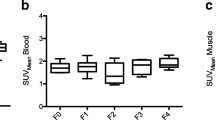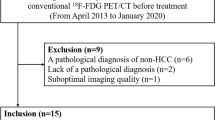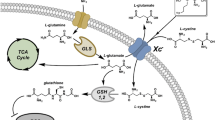Abstract
Objective
To compare differences in global measures of hepatic metabolism between control subjects and subjects with cirrhosis.
Materials and methods
FDG-PET/CT scans of 33 subjects either without or with cirrhosis were analyzed retrospectively and classified as follows: group 1 includes subjects without cirrhosis or extrahepatic malignancy (1a) (n = 11) and subjects without cirrhosis but with history of extrahepatic malignancy (1b) (n = 10); group 2 includes subjects with cirrhosis and history of extrahepatic malignancy (n = 12). Subjects with focal hepatic lesions, prior hepatic surgery, co-existing liver pathology, or who received chemotherapy or radiation therapy within the last 6 months were excluded. The hepatic volumes, hepatic mean standardized uptake value (SUVmean), and global hepatic glycolysis (GHG) were compared between groups.
Results
Subjects with cirrhosis showed a lower average hepatic SUVmean as compared to non-cirrhotic patients (1.55 ± 0.29 for group 2 versus 1.81 ± 0.23 for group 1; p value = 0.009) and lower average values for GHG (2238.29 ± 903.60 for group 2 versus 2974.67 ± 829.16 for group 1; p value = 0.024). No differences were noted between the non-cirrhotic subgroups (i.e., between the groups 1a and 1b) without and with associated extrahepatic malignancy, respectively.
Conclusions
We hypothesize that presence of fibrosis, reduction of active inflammation, and decreased hepatic metabolism and function are potential causes of the lower FDG uptake in cirrhotic livers. Our results also indicate that extrahepatic cancer status does not influence FDG uptake in the non-cirrhotic liver in subjects without hepatic metastases.

Similar content being viewed by others
References
Hansen L, Sasaki A, Zucker B. End-stage liver disease: challenges and practice implications. Nurs Clin North Am. 2010;45(3):411–26.
Schuppan D, Afdhal NH. Liver cirrhosis. Lancet. 2008;371(9615):838–51.
Udell JA, Wang CS, Tinmouth J, FitzGerald JM, Ayas NT, Simel DL, et al. Does this patient with liver disease have cirrhosis? JAMA. 2012;307(8):832–42.
Riley TR, Taheri M, Schreibman IR. Does weight history affect fibrosis in the setting of chronic liver disease? J Gastrointestin Liver Dis. 2009;18(3):299–302.
Wanless IR, Nakashima E, Sherman M. Regression of human cirrhosis. Morphologic features and the genesis of incomplete septal cirrhosis. Arch Pathol Lab Med. 2000;124(11):1599–607.
Desmet VJ, Roskams T. Cirrhosis reversal: a duel between dogma and myth. J Hepatol. 2004;40(5):860–7.
de Graaf W, Bennink RJ, Vetelainen R, van Gulik TM. Nuclear imaging techniques for the assessment of hepatic function in liver surgery and transplantation. J Nucl Med. 2010;51(5):742–52.
Fierbinteanu-Braticevici C, Purcarea M. Non-biopsy methods to determine hepatic fibrosis. J Med Life. 2009;2(4):401–6.
Wang Y, Ganger DR, Levitsky J, Sternick LA, McCarthy RJ, Chen ZE, et al. Assessment of chronic hepatitis and fibrosis: comparison of MR elastography and diffusion-weighted imaging. AJR Am J Roentgenol. 2011;196(3):553–61.
Sohail S. Hepatic fibrosis imaging: trends and feasibility. J Coll Physicians Surg Pak. 2012;22(2):73–4.
Brancatelli G, Baron RL, Federle MP, Sparacia G, Pealer K. Focal confluent fibrosis in cirrhotic liver: natural history studied with serial CT. AJR Am J Roentgenol. 2009;192(5):1341–7.
Lenhart M, Feuerbach S. Role of computed tomography and magnetic resonance imaging in the diagnosis of hepatitis and liver cirrhosis. Praxis (Bern 1994). 2005;94(16):635–8.
Yoshida M, Shiraishi S, Sakaguchi F, Utsunomiya D, Tashiro K, Tomiguchi S, et al. A quantitative index measured on (9)(9)mTc GSA SPECT/CT 3D fused images to evaluate severe fibrosis in patients with chronic liver disease. Jpn J Radiol. 2012;30(5):435–41.
Yoshida M, Shiraishi S, Sakaguchi F, Utsunomiya D, Tashiro K, Tomiguchi S, et al. Fused 99m-Tc-GSA SPECT/CT imaging for the preoperative evaluation of postoperative liver function: can the liver uptake index predict postoperative hepatic functional reserve? Jpn J Radiol. 2012;30(3):255–62.
Kwon AH, Matsui Y, Ha-Kawa SK, Kamiyama Y. Functional hepatic volume measured by technetium-99m-galactosyl-human serum albumin liver scintigraphy: comparison between hepatocyte volume and liver volume by computed tomography. Am J Gastroenterol. 2001;96(2):541–6.
Onodera Y, Takahashi K, Togashi T, Sugai Y, Tamaki N, Miyasaka K. Clinical assessment of hepatic functional reserve using 99mTc DTPA galactosyl human serum albumin SPECT to prognosticate chronic hepatic diseases—validation of the use of SPECT and a new indicator. Ann Nucl Med. 2003;17(3):181–8.
Kaibori M, Ha-Kawa SK, Maehara M, Ishizaki M, Matsui K, Sawada S, et al. Usefulness of Tc-99m-GSA scintigraphy for liver surgery. Ann Nucl Med. 2011;25(9):593–602.
Alavi A, Kung JW, Zhuang H. Implications of PET based molecular imaging on the current and future practice of medicine. Semin Nucl Med. 2004;34(1):56–69.
Musiek ES, Chen Y, Korczykowski M, Saboury B, Martinez PM, Reddin JS, et al. Direct comparison of fluorodeoxyglucose positron emission tomography and arterial spin labeling magnetic resonance imaging in Alzheimer’s disease. Alzheimers Dement. 2012;8(1):51–9. doi:10.1016/j.jalz.2011.06.003.
Ewers M, Insel PS, Stern Y, Weiner MW. Cognitive reserve associated with FDG-PET in preclinical Alzheimer disease. Neurology. 2013;80(13):1194–201. doi:10.1212/WNL.0b013e31828970c2.
Kuker RA, Mesoloras G, Gulec SA. Optimization of FDG-PET/CT imaging protocol for evaluation of patients with primary and metastatic liver disease. Int Semin Surg Oncol. 2007;4:17.
Lin CY, Ding HJ, Lin CC, Chen CC, Sun SS, Kao CH. Impact of age on FDG uptake in the liver on PET scan. Clin Imaging. 2010;34(5):348–50.
Alavi A, Newberg AB, Souder E, Berlin JA. Quantitative analysis of PET and MRI data in normal aging and Alzheimer’s disease: atrophy weighted total brain metabolism and absolute whole brain metabolism as reliable discriminators. J Nucl Med. 1993;34(10):1681–7.
Abdulla S, Salavati A, Saboury B, Basu S, Torigian DA, Alavi A. Quantitative assessment of global lung inflammation following radiation therapy using FDG PET/CT: a pilot study. Eur J Nucl Med Mol Imaging. 2013. doi:10.1007/s00259-013-2579-4.
Fonti R, Larobina M, Del Vecchio S, De Luca S, Fabbricini R, Catalano L, et al. Metabolic tumor volume assessed by 18F-FDG PET/CT for the prediction of outcome in patients with multiple myeloma. J Nucl Med. 2012;53(12):1829–35. doi:10.2967/jnumed.112.106500.
Lim R, Eaton A, Lee NY, Setton J, Ohri N, Rao S, et al. 18F-FDG PET/CT metabolic tumor volume and total lesion glycolysis predict outcome in oropharyngeal squamous cell carcinoma. J Nucl Med. 2012;53(10):1506–13. doi:10.2967/jnumed.111.101402.
Berkowitz A, Basu S, Srinivas S, Sankaran S, Schuster S, Alavi A. Determination of whole-body metabolic burden as a quantitative measure of disease activity in lymphoma: a novel approach with fluorodeoxyglucose-PET. Nucl Med Commun. 2008;29(6):521–6. doi:10.1097/MNM.0b013e3282f813a4.
Chen HH, Chiu NT, Su WC, Guo HR, Lee BF. Prognostic value of whole-body total lesion glycolysis at pretreatment FDG PET/CT in non-small cell lung cancer. Radiology. 2012;264(2):559–66. doi:10.1148/radiol.12111148.
Liao S, Penney BC, Wroblewski K, Zhang H, Simon CA, Kampalath R, et al. Prognostic value of metabolic tumor burden on 18F-FDG PET in nonsurgical patients with non-small cell lung cancer. Eur J Nucl Med Mol Imaging. 2012;39(1):27–38. doi:10.1007/s00259-011-1934-6.
Francis RJ, Byrne MJ, van der Schaaf AA, Boucek JA, Nowak AK, Phillips M, et al. Early prediction of response to chemotherapy and survival in malignant pleural mesothelioma using a novel semiautomated 3-dimensional volume-based analysis of serial 18F-FDG PET scans. J Nucl Med. 2007;48(9):1449–58. doi:10.2967/jnumed.107.042333.
Dibble EH, Alvarez AC, Truong MT, Mercier G, Cook EF, Subramaniam RM. 18F-FDG metabolic tumor volume and total glycolytic activity of oral cavity and oropharyngeal squamous cell cancer: adding value to clinical staging. J Nucl Med. 2012;53(5):709–15. doi:10.2967/jnumed.111.099531.
Basu S, Zaidi H, Houseni M, Bural G, Udupa J, Acton P, et al. Novel quantitative techniques for assessing regional and global function and structure based on modern imaging modalities: implications for normal variation, aging and diseased states. Semin Nucl Med. 2007;37(3):223–39.
Bural GG, Torigian DA, Burke A, Houseni M, Alkhawaldeh K, Cucchiara A, et al. Quantitative assessment of the hepatic metabolic volume product in patients with diffuse hepatic steatosis and normal controls through use of FDG-PET and MR imaging: a novel concept. Mol Imaging Biol. 2010;12(3):233–9.
Abele JT, Fung CI. Effect of hepatic steatosis on liver FDG uptake measured in mean standard uptake values. Radiology. 2010;254(3):917–24.
Dostbil Z, Varoglu E, Serdengecti M, Kaya B, Onder H, Sari O. Evaluation of hepatic metabolic activity in non-alcoholic fatty livers on (18)FDG PET/CT. Rev Esp Med Nucl Imagen Mol. 2013;32(3):156–61. doi:10.1016/j.remn.2012.04.006.
Geraghty EM, Boone JM, McGahan JP, Jain K. Normal organ volume assessment from abdominal CT. Abdom Imaging. 2004;29(4):482–90.
Kamimura K, Nagamachi S, Wakamatsu H, Higashi R, Ogita M, Ueno S, et al. Associations between liver (18)F fluoro-2-deoxy-d-glucose accumulation and various clinical parameters in a Japanese population: influence of the metabolic syndrome. Ann Nucl Med. 2010;24(3):157–61. doi:10.1007/s12149-009-0338-1.
Meier JM, Alavi A, Iruvuri S, Alzeair S, Parker R, Houseni M, et al. Assessment of age-related changes in abdominal organ structure and function with computed tomography and positron emission tomography. Semin Nucl Med. 2007;37(3):154–72.
Bural GG, Torigian DA, Chen W, Houseni M, Basu S, Alavi A. Increased 18F-FDG uptake within the reticuloendothelial system in patients with active lung cancer on PET imaging may indicate activation of the systemic immune response. Hell J Nucl Med. 2010;13(1):23–5.
Nicoll A. Surgical risk in patients with cirrhosis. J Gastroenterol Hepatol. 2012;27(10):1569–75. doi:10.1111/j.1440-1746.2012.07205.x.
Kamath PS, Kim WR. The model for end-stage liver disease (MELD). Hepatology. 2007;45(3):797–805. doi:10.1002/hep.21563.
Asrani SK, Kim WR. Model for end-stage liver disease: end of the first decade. Clin Liver Dis. 2011;15(4):685–98. doi:10.1016/j.cld.2011.08.009.
Sorensen M, Mikkelsen KS, Frisch K, Villadsen GE, Keiding S. Regional metabolic liver function measured by 2-[(18)F]fluoro-2-deoxy-d-galactose PET/CT in patients with cirrhosis. J Hepatol. 2013; 8278(13). doi: 10.1016/j.jhep.2013.01.012.
Chopra A. 18F-labeled neogalactosylalbumin. Molecular Imaging and Contrast Agent Database (MICAD). National Center for Biotechnology Information (US); 2009. pp. 2004–13.
Slimani L, Kudomi N, Oikonen V, Jarvisalo M, Kiss J, Naum A, et al. Quantification of liver perfusion with [(15)O]H(2)O-PET and its relationship with glucose metabolism and substrate levels. J Hepatol. 2008;48(6):974–82.
Nishiguchi S, Shiomi S, Kawamura E, Ishizu H, Habu D, Torii K, et al. Evaluation of ammonia metabolism in the skeletal muscles of patients with cirrhosis using N-13 ammonia PET. Ann Nucl Med. 2003;17(5):417–9.
Dam G, Keiding S, Munk OL, Ott P, Buhl M, Vilstrup H, et al. Branched-chain amino acids increase arterial blood ammonia in spite of enhanced intrinsic muscle ammonia metabolism in patients with cirrhosis and healthy subjects. Am J Physiol Gastrointest Liver Physiol. 2011;301(2):G269–77.
Matusch A, Meyer PT, Bier D, Holschbach MH, Woitalla D, Elmenhorst D, et al. Metabolism of the A1 adenosine receptor PET ligand [18F]CPFPX by CYP1A2: implications for bolus/infusion PET studies. Nucl Med Biol. 2006;33(7):891–8.
Sorensen M, Mikkelsen KS, Frisch K, Bass L, Bibby BM, Keiding S. Hepatic galactose metabolism quantified in humans using 2-18F-fluoro-2-deoxy-d-galactose PET/CT. J Nucl Med. 2011;52(10):1566–72.
Conflict of interest
The authors declare no conflict of interest.
Author information
Authors and Affiliations
Corresponding author
Additional information
A. Hernandez-Martinez, V. A. Marin-Oyaga, and A. Salavati contributed equally to this study.
Rights and permissions
About this article
Cite this article
Hernandez-Martinez, A., Marin-Oyaga, V.A., Salavati, A. et al. Quantitative assessment of global hepatic glycolysis in patients with cirrhosis and normal controls using 18F-FDG-PET/CT: a pilot study. Ann Nucl Med 28, 53–59 (2014). https://doi.org/10.1007/s12149-013-0780-y
Received:
Accepted:
Published:
Issue Date:
DOI: https://doi.org/10.1007/s12149-013-0780-y




